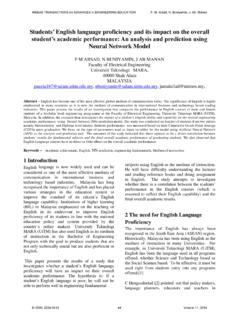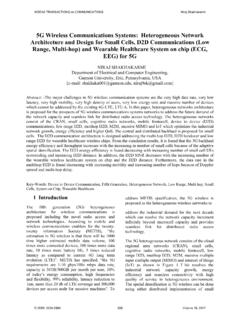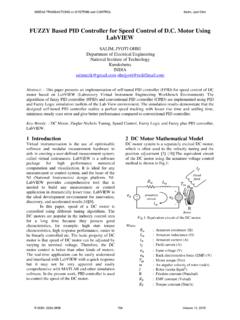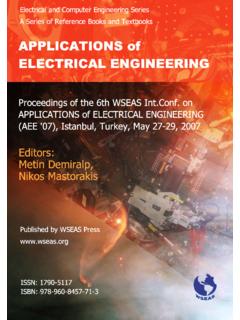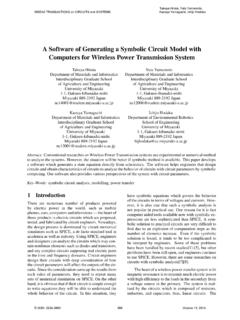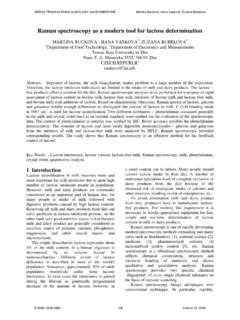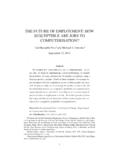Transcription of Impact of morphological and functional features on ...
1 Impact of morphological and functional features on hospitals energy consumption: A comparative analysis of six case studies M. COCCAGNA 1, S. CESARI 2, P. VALDISERRI 3, P. ROMIO 4, S. MAZZACANE 1 1 CIAS Research Center for pollution control in high sterility rooms, Department of Architecture University of Ferrara via Saragat 13, 44122 Ferrara, ITALY 2 Department of Architecture University of Ferrara via della Ghiara 36, 44121 Ferrara, ITALY 3 Department of Industrial Engineering University of Bologna Viale Risorgimento 2, 40136 Bologna, ITALY 4 AUSL Bologna Via Castiglione 29, 40124 Bologna, ITALY Abstract: - Due to their 24/7 operation and having to meet strict mandatory requirements for indoor air quality and sterility [1-3], hospitals are among the most energy-intensive facilities [4], thus significantly contributing to greenhouse gas emissions [5]. Even more alarming, however, is that while the steady evolution in healthcare delivery requires the continuous remodelling of the spaces in operative structures, involving both architectural-distributive aspects and building plant systems and therefore underlining the need of forecasting the changing hospital energy needs - energy analyses are still rarely based on departmental level, thus hospital energy consumption by space type remains largely unexplained.
2 The objective of the work is the development and experimental validation of a numerical model for the annual energy consumption assessment of six hospitals located in the province of Bologna (Italy), in relation to the morphological features of the buildings and the characteristics of the envelope, the different medical functions, the typology, operating conditions and hours of the plant systems, the comfort needs of patient and healthcare staff, etc. Aimed at addressing the weaknesses of the studies available in literature, the methodological framework represents the main aspect of the work. The model was based on the identification of the energy needs and consumptions from micro (single spaces) to macro scale (macro-area) and was then tested for each healthcare facility through the exclusive use of measurement data. The numerical model enables to forecast the energy consumption variations and, what is the most important, the saving potential related to the renovation or layout modification of existing healthcare facilities, this analysing the Impact of architectural and functional features , together with energy goals.
3 Besides functional and morphological evaluations about the six case studies examined, this paper outlines the preliminary results of the work and reports in a parametric form the findings regarding the distribution of the conditioned floor area and of the external surface in relation to the type of spaces. Key-Words: - hospitals, energy consumption, morphological aspects, functional features , measurement data, benchmarking, prediction 1 Introduction Buildings are the largest energy consuming sector in the world [6], accounting for 20% of the total delivered energy consumed [7]. At EU level, the building sector is responsible for 40% of final energy consumption and 36% of green-house gas emissions [4, 8-10], one third of this is due to non-residential buildings [11]. Whilst accounting for 7,5% of the total built area within the non-residential sector [12], hospitals present the highest energy consumption per unit of floor area [13].
4 They contribute 10% of the total energy use [4] and WSEAS TRANSACTIONS on ENVIRONMENT and DEVELOPMENT M. Coccagna, S. Cesari, P. Valdiserri, P. Romio, S. MazzacaneE-ISSN: 2224-3496212 Volume 14, 2018are estimated to account for roughly 5% of the EU carbon dioxide emissions [5] (in 2013 the healthcare sector produced of the national total [14]). Therefore, while they should be designed to improve public health and respect the environment, hospitals are actually contributing to the very problem they are trying to solve, and their negative effects are proportional to their age. Taking into consideration the EU healthcare building stock, an average of 60% of the structures date back to before 1980 (a percentage ranging from 76% in Hungary to 74% in Sweden, 66% in Germany, 53% in Poland, and 30% in Spain), while only about 15% were built after 2000 [15]. As regards the Italian context, the majority of the healthcare building stock (66%) is characterised by structures opened between 1950 and 2000, outdated both from the architectural and operational point of view, while only the 30% of the complexes were built in the last twenty years [16].
5 High hospitals energy consumptions are mostly due to extremely high demands for space heating and cooling throughout the year, caused by the need of high ventilation rates and the strict requirements for microclimatic control [1-3]. Also the demand of district hot water (DHW) is substantial [17], as well as the need of electricity [18-20, 21, 22]. Moreover, hospitals energy profile is constantly affected and transformed by the steady evolution in healthcare delivery. The fast-moving progresses in medical technologies and equipment, along with the rapid advances in the diagnostic techniques and treatment procedures, require the continuous remodelling of the spaces in operative healthcare structures and highly modify hospital energy needs. This process, involving both architectural-distributive aspects and the progressive adaption of the building plant systems, underlines the need of forecasting these new dynamics also in terms of costs.
6 Indeed, the economic sustainability of a healthcare facility results to be a fundamental aspect. At European level, the global health expenditure has risen of about 20% in the last twenty years, reaching 30% for the Italian context and bringing healthcare management to an unsustainable condition [23]. Albeit energy costs are often seen as fixed costs, in the financial performance of the hospital every dollar saved in energy and operating costs is equal to generating $20 growth in new top line revenues [24]. Therefore, energy savings can be viewed as an ongoing, high yield, low risk investment or revenue stream that enable to reduce costs without impacting medical services. Against this background, and in view of the increasingly stringent energy efficiency targets and environmental issues, the need of a more robust and reliable focus on hospital energy assessment is becoming more and more important, also considering that a growing number of studies have uncovered a mismatch between the predicted energy performance of buildings and their actual measured energy use and resulting utility bills, an issue addressed as the performance gap [25-28].
7 Nevertheless, the assessment of energy performance and retrofit potentials for hospital buildings is very arduous because of the substantial size, energy-intensity and heterogeneity [29], together with the lack of energy data from a sufficiently large number of buildings for benchmarking [21]. In the following section, a state of the art review of the existing studies about the evaluation and prediction of hospital energy behaviour is reported. 2 State of the art The current scientific literature about energy performance assessment and forecasting models for healthcare facilities includes a huge variety of approaches which largely differ in the method of analysis , the energy issues investigated, the type of building existing or prototype or hospital spaces to which the method is applied, as well as the scale at which the research work is conducted.
8 The main methods are briefly reviewed in [28]. Here are presented the first-principle models, which span from stationary calculations, via semi-dynamic methods, to dynamic simulation; the machine learning approach, which requires training data provided by either measurements or first-principle models, and covers techniques such as regression analysis , artificial neural networks, support vector machines; measurements, which include metering the energy delivered at building or sub-systems level on the basis of different temporal resolution (from annual intervals to only a few minutes or even seconds) and allow to capture energy-related data, such as indoor and outdoor conditions, occupancy, and control systems. An analysis of the studies available in literature shows that the majority of the works are based only on dynamic thermal simulation models [24, 29-37], albeit some recent approaches also employ measurement data in order to calibrate the model [16, 38-43].
9 Indeed, since the late 70s, building simulation is a well-recognized method for the building energy performance assessment [44]. Furthermore, as this approach requires the use of WSEAS TRANSACTIONS on ENVIRONMENT and DEVELOPMENT M. Coccagna, S. Cesari, P. Valdiserri, P. Romio, S. MazzacaneE-ISSN: 2224-3496213 Volume 14, 2018energy simulation programs, nowadays its application is increasing wider and wider due to mature and diffuse ICT technologies. The method is used both to predict the indoor air temperature and humidity in time-dependent external weather conditions and to assess the influence of different buildings features on the building thermohygrometric behaviour and comfort [45]. Nevertheless, simulation-based methods are characterised by several difficulties in properly modelling the building-HVAC system for large structures, like hospitals, and by time consuming simulations.
10 Large models can also limit the number of possible simulations, since even modest retrofit proposals could imply changes to many parameters [16]. Conversely, simplified steady-state models, often purposely developed, are based on empirical and/or experimental mathematical models. In particular, the adoption of simplified methodologies related to several control techniques able to assess the possibilities for increasing energy efficiency in hospitals were presented in Refs. [15, 46]. Here, the tool, which was tested and calibrated at the new emergency hospital located in Novi Sad, Serbia, enables fast analyses by avoiding complex dynamic modelling. Finally, some approaches are based only on on-site measurements [19, 21, 22]. Taking into consideration the energy aspects investigated, it arises that, although a comprehensive analysis of the energy behaviour of hospital buildings should consider all levers affecting energy performance, current scientific literature does not provide worthy studies that explored all the energy related aspects.
